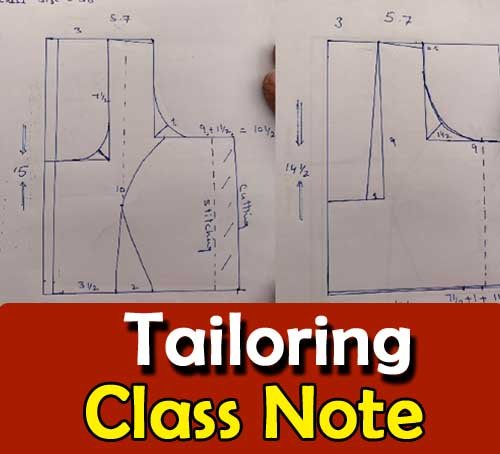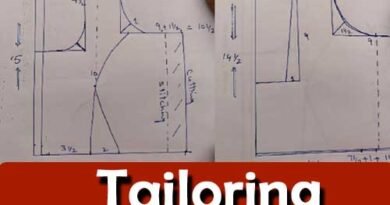Types of Faults and Defects
The different types of faults and defects found in garments can be categorised as:
Preproduction Defects
Stitching Defects
Fabric Defects
Preproduction Defects
Pattern Making Defects
Shaded parts
Mismatched Plaids.
Marker too wide or narrow
Unsymmetrical pieces
Poor line definition (e.g.. chalk line too thick or thin)
Spreading Defects
Improper matching or the material is facing the wrong way
Material too narrow or wide
Improper tension-Material spread too tight or loose
Narrow material-Marker width is not covered because the material is too narrow
Cutting Defects
Improper cutting: Not following the pattern and marker lines,
Frayed or unsharpened knife: Causes uneven or frayed edges
Notches Too deep or shallow or completely omitted.
Drill Marks Not perpendicular, omitted or wrong drill used
Mixed piles:Resulting in shaded garment part when assembled
Bundling and Ticketing faults
It is very necessary to ensure numbering, sorting and bundling of the cut products is done properly. If it is not done accurately it might result in mismatched products. For example if the lining materials are not numbered and stacked properly, it might be wrongly used on a garment
Fabric Defects
Coloured flecks: This is caused due to the presence of foreign material in the yarn
Knots: Knots are caused when the thread breaks during the process of winding or weaving of the yarn. This is a non-amenable defect.
Broken pattern: When there is a non-continuity in the pattern. design or weave caused due to the non-drawing in of threads
Hole, cut or tear: are caused due to various factors such as sharp edges on cloth roll using the wrong kind of cutting material, hard substance between layers of fabric etc
Untrimmed loose threads: Is caused if the tail ends are not trimmed after piecing up This defect can easily be rectified with the help of clippers
Stitching Defects
Skipped Stich: The common cause for this would be if the machine is. incorrectly threaded, the needle is damaged, Needleis Not Suitable For the thread used Thread is too fine or thick Fabric is not held correctly
Thread Breaks: If poor quality thread is used improper setting of needle and bad quality needle. Machine is dirty and thread is inserted incorrectly, Machine operator did not release tension before removing the material
Seam pucker: Happens if the fabric is very light, not held properly and too tightly woven. Also if the thread is of wrong size and is too tight If the needle needs replacing, the thread and needle do not go together
Excessive Seam Grin: Occurs when the sewing machine thread is not inserted properly and there is a tension
Re stitched seams/Broken Stitches: is caused if the thread breaks or the machine runs out of thread during sewing or happens during the treatment of the finished product
Open seam: Is caused if the thread strength is inadequate and if there is not enough stitches per inch
Seam failure: Is caused if the fabric is week or loosely constructed
Improper stitch balance: Bad quality thread, the bobbin thread tension is not set correctly and the minimum straight to get a balanced stitch is not obtained.
Ragged Edge: Caused when the sewing machine knives are not sharpened and changed often
Example of faults and their remedies
| Location | Defects | Causes | Remedies |
| Collar | Both points are not aligned. | Pattern mistake | Proper pattern marking |
| Strip or check is not match accurately /stitch | Pattern mistake | Proper mitering | |
| Collar flat or not | Improperly stitch/seam | Proper folding & stitching | |
| Size | Incorrect size parts | Improper ticketing & bundling | Proper ticketing & bundling |
| Button & button hole | Not placed in right place | proper marking marking | proper marking |
| Unevenness of gap between one button to other | Improper measuring & marking | proper marking | |
| Stitch is done correctly / extra thread | Improper stitching /machine setting | proper setting of machines | |
| Broken button | Improper inspection | Replace | |
| Sleeve | Unequal size | Improper measurement/ stitching | Improper measurement marking, & stitch. |
Woven Fabric Defect
Defect Explanation Severity Photography
Dropped pick
Caused by the filing insection .Mechanism on a shuttle less loom not holding the filing yarn, causing the filing yarn to be woven without tension. The filing yarn appears as “kinky”.
End out: Caused by yarn breaking and loom continuing to run with missing end.
Slib: Usually caused by an extra piece of yarn that is woven into fabric. It can also be caused by thick places in the yarn . often is caused by fly waste being spun in yarn in the spinning process.
Knots: Caused by tying spools of yarn together .
Mixed End (Yarn): Yarn of a different fiber blend used on the wrap frame.resulting in a streak in the fabric.
Mixed Filling:Caused by bobbin of lightweight yarn or different fiber blend used in filling. Will appear as a distinct shade change.
Solled Filling or End: Dirty, oil looking spots on the wrap or filling yarns.or on package- dyed yarn.
Other Knitted Fabric Defect
Drop Stitches: Results from malfunctioning needle or jack. Will appear as holes or missing stitches.
Hole: Caused by broken needle.
Missing yarn: Occurs in circular knit. Caused by one end of yarn missing from feed and machine continuing to run.
Mixed Yarn: Occurs in wrap knit. Result from wrong Fiber yarn (or wrong size yarn) placed on wrap. Fabric could appear as thick end or different color if fibres have different affinity for dye.
Needle Line: Caused by bent needle forming distorted stitches usually verticals line.
Flunner: Caused by broken needle. Will appear as vertical line. (Most machine have stopping device to stop machine when a needle break.)
Slub: Usually caused by a thick or heavy place in yarn, or by lint getting into yarn feeds.
Askewed or Blas: Condition where filling yarns are not square with wrap yams on woven fabrics or where courses are not square with wale lines on knits.
Pin holes: Holes along selvage caused by pins holding fabric while processes through stentre frame.
Straying End: Caused when an end of yarn breaks and loose end strays and is knit irregularly into another area.
Bowing: Usually caused by finishing in knits. The course lines lie in an arc across width of goods.
Accessory Defects
ZIPPERS
Slider defect
Won’t Lock Not apparent without testing by placing Zipper. slider locked position and applying tension. Faulty Dimension Not readily apparent May cause either a hard or a loose operating zipper. Either condition may result in zipper failure before garment is worn out Crushed Slider May be due to improper garment pressing or due to padding or compensating springs in the presses not being in best condition. Tarnished Does not generally interfere with operating qualities but is a matter of appearance only. Judging” this defect depending upon degree of tarnish Burn or Rough Spots Not immediately apparent. Can cause snagging and early wear on the upper tape. Lock Prong Interferes Indicated by pull-tab not staying in locked position or slider not moving freely after being released from locked position. Weak Slider Bodies: Can best be determined with proper testing equipment. However, manifests itself by slider becoming compressed or crushed under minimum pressure or becoming distorted enough to create hard operation.
Chain or
Teeth Defect
Improper Dimensions: Not always apparent unless slider works with great difficulty or operates too easily. Zipper may give initial satisfactory operation but fail after only moderate use and especially after laundering or dry cleaning. Miss meshed and Unmeshed Teeth: Readily Cord not
visible particularly in large Usually results in inoperable zipper Missing Teeth Readily visible will result in early failure of the tipper Misplaced Teeth. This refers to a tooth being out of pounon, and occasionally may involve two or three teeth Seriousness anges from tedling to almost as serious as a massing tooth depending upon the degree of misplacement and general design of zipper Off colour This defect is quite apparent.
Zipper manufacturers normally carry a complete range of tape colours Due to umilarity of different colors one may be mistaken for another it is also possible because of color similarities or difference in dye lots that the two halves of the zipper will have two different shades of tape Humpy Chain Readily noticeable by its waviness Causes difficulty at sewing operation and distorts finished garment’s appearance Attached to Tape Due to skipped shitches during operation of sewing cord to tape Not readily apparent but under strain cord and teeth will rip away from tape and render zipper and garment unusable Length improper ripper length for given opening


